The Mack is Back! After a long summer hiatus, I’m back with fresh updates.
A lot has happened in the intervening weeks, and it would be helpful to provide an update on my views on my prior posts, starting with the elections. This post will run a little long, so I’ll return in a few days with updates to my views on Gold, Equities, U.S. Real Estate etc.
U.S. Elections
Joe Biden being elected President is now my base case. That change in view is driven by the fact that his wide lead in the polls has remained eerily steady and consistent, compared to a much wider dispersion in the polls for Hillary entering into the elections. Biden is consistently polling higher than Hillary did at this point in 2016, and his disapproval rating has remained much lower than hers.
The Washington Post put it nicely: The stability of the margins in the 2020 race has been remarkable, even in the context of the past five elections. In 2000, 2004, 2008, 2012 and 2016, there was at some point a tie in the polling average in the last 150 days of the race. Not this year. This year, there hasn’t even been a moment in which Biden’s lead was as narrow as five points.

Why is that? I think the polls are reflecting Trump fatigue. Enough of the electorate was willing to give Trump a chance over an unpopular Hillary in 2016, but perhaps some voters outside of his rabid base have gotten tired of all the antics and shenanigans. This fatigue may be reflected in the number of undecided voters: only an estimated 5% of voters remain undecided vs. ~14% at this time in 2016.
I had been watching the Sept 29th Presidential debate as an important milestone, and Biden easily cleared a low bar in his first (and perhaps only?) attempt, aided in no small part by Trump’s belligerent behavior, which allowed Biden to sidestep having to provide detailed explanations on his policies. Further, there is no sign of a “sympathy bump” for Trump following his covid diagnosis, and since his (mis)handling of the coronavirus is a key weakness, this only serves to shine the spotlight further on the administration’s deplorable covid response.
Still a close election: However, all that being said, this may be a much closer election than the people who are talking of a democratic “Blue Wave” seem to believe. The main reason for this is the peculiarities of the electoral college system of voting. While Biden is almost certain to win the popular vote by a significant margin (I see this as a 99% probability), losing just a few key states could cost him the election.
Florida is key: At this point, I see Trump narrowly winning Florida (29 electoral votes), driven in part by the inroads he’s made with the Hispanic population in the state. This is huge since Trump winning Florida is what makes this a tight race in my mind. If Trump loses Florida, it’s lights out for him. Biden is then likely to win bigly in a landslide and take many of the toss-up states. Nate Silver’s 538 model gives the Biden landslide scenario a 34% probability. Trump winning Florida would complicate the math for Biden, but Biden would still have a reasonable path to victory.

Election Scenarios: I ran some scenarios on the New York Times’ excellent election website, and this how I see it with a reasonable degree of confidence:
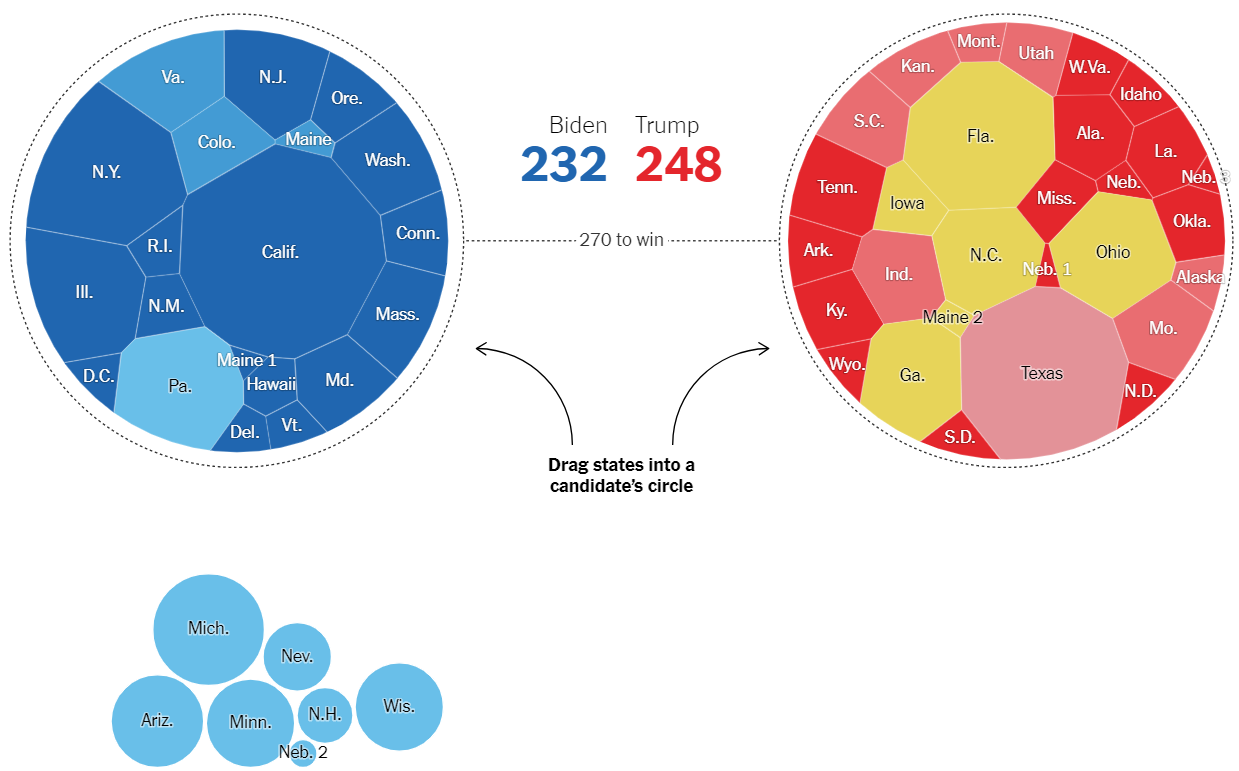
I see Trump (narrowly) winning Florida (29 votes), Ohio (18), North Carolina (15), Georgia (16), giving him 248 electoral votes (and possibly 258 if he wins Wisconsin, which is too close for me too call). Pennsylvania (20) is close, but the polling lead has widened just enough for me to give it to Biden. Biden needs to win most of the states in blue below the circle to get to the 270 votes required to win. I think he will win most of these states, notably Michigan (16), and Minnesota (10), but both Arizona (11) and Wisconsin (10) are too close for me too call. If Trumps wins those two states, we could have a tie!
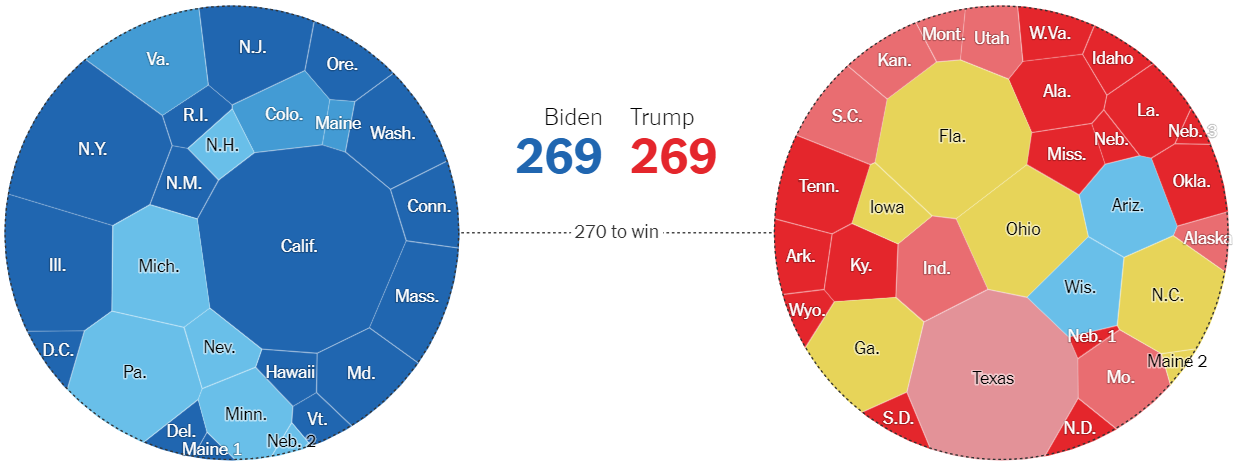
Here’s what the polling looks like, again from the NYT:
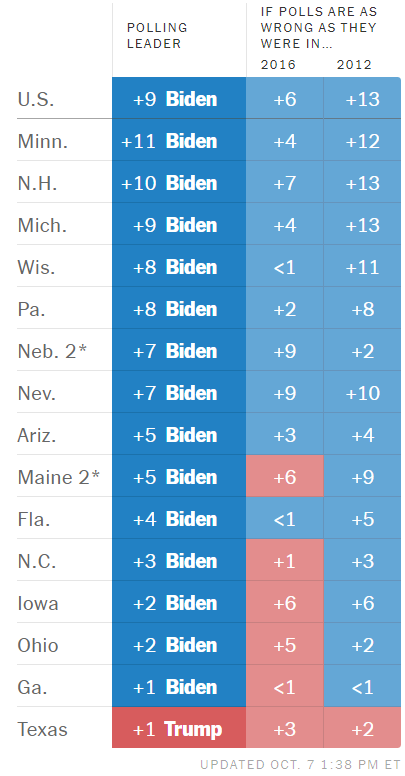
The NYT helpfully shows the margin if the polls are as wrong as they were in 2016, which should capture much of the “hidden” Trump vote that the polls failed to capture in 2016. Even with the expectation that pollsters have made their polls smarter over the last 4 years, I’ve used this table as a worst-case scenario to give Trump the states of Florida, North Carolina, Iowa, Ohio and Georgia (and possibly Wisconsin). Again, if Trump loses Florida, this likely reflects the national mood, and Trump will likely lose many of these states and other toss-up states as well.
Notice how close the race is in the table above. Arizona (11) and Wisconsin (10) are too close for me to have any comfort that Biden will cruise to victory in those states. Arizona has voted Democratic only once since 1972! In contrast, Wisconsin has consistently voted for a Democrat since 1992, with the exception of Trump in 2016.
Pennsylvania (20 votes) is very close as well, and since it doesn’t count votes until election night, we may not see decisive results published for some time. I do have Biden winning Pennsylvania based on the inroads he’s made with older, white voters, especially white working class women. The state has consistently voted for a Democrat since 1992, with the exception of Trump in 2016. For what its worth, 538 gives Biden a strong 85% probability of winning Pennsylvania. If Trump does win Florida, winning Pennsylvania would likely seal his victory.
Prediction Markets: Nate Silver’s 538 model gives Trump a 16% probability of winning the election. In 2016, they gave him a 30% chance of winning entering the election. The RealClearPolitics betting average now shows Trump with a 35% probability of winning, falling sharply from almost 50% barely a month ago. PredictIt is in the same ballpark. I think 538’s 16% is too low, and the probability is closer to 40%.
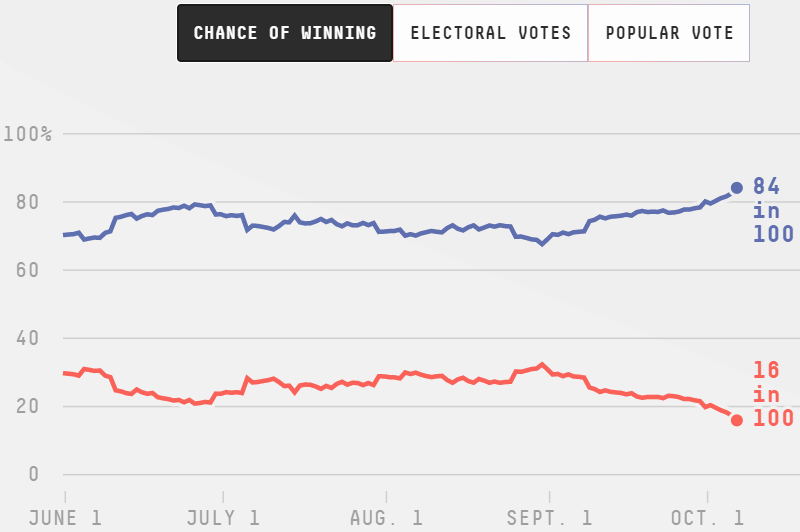
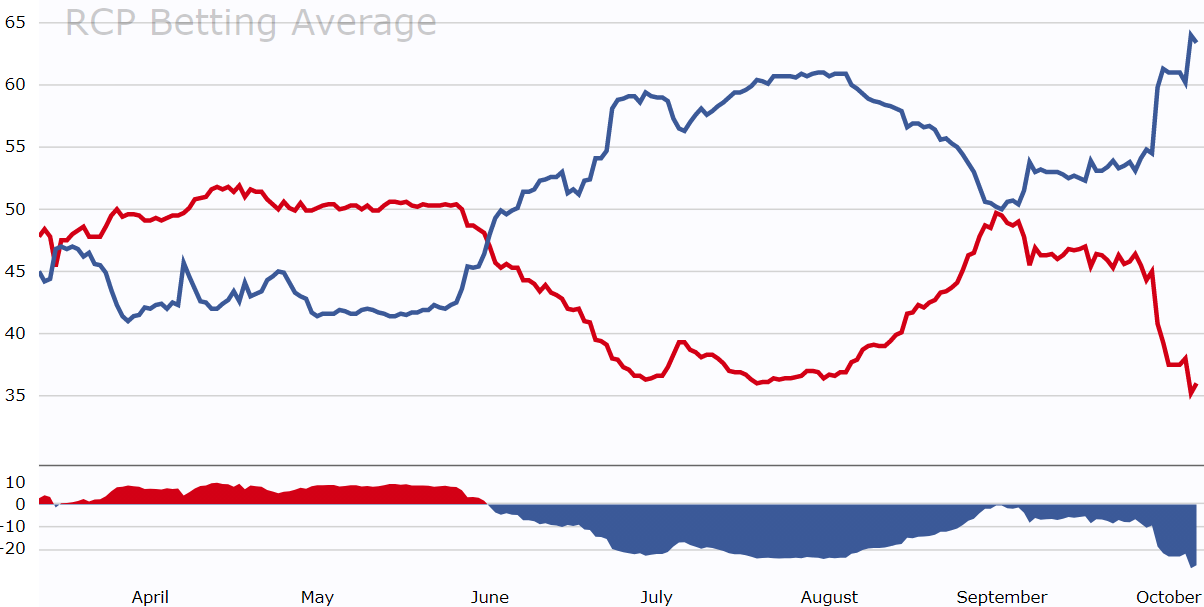

Contested Election: I see a contested election/constitutional crisis as very unlikely. The states to watch with some caution are Michigan, Pennsylvania and Wisconsin where early ballot processing is not allowed, leading to potential delays in counting mail-in ballots and declaring results.
However, I believe that the results in a few key counties will provide an accurate-enough barometer for seasoned poll watchers and the media to get a good sense for how the race is going. Indeed, there are several key swing states that do allow early ballot processing and counting, and where results should be available fairly early: Arizona, Florida, North Carolina and Ohio. Voting trends in these states and their underlying counties will serve as excellent barometers of the national mood.
Perhaps this is wishful thinking, but I do believe there still exists a quiet majority of influential people (politicians, business leaders, media persons) where good sense will prevail. Also, when the average person on the street is openly fretting about a contentious lawsuit-ridden post-election period, I will always be tempted to take the opposite view. We’ll see how it goes…
Subscribe for free to get full access to the newsletter and website. No spam, no marketing lists.
Mack Row
I’m a Global Macro investor with years of investing experience at some of the largest hedge funds and institutional investment firms in the world. My goal is to educate people about investing and hopefully make them more thoughtful investors. I also want to help investors navigate their way through the treacherous investing environment of the 2020s.
Disclaimer: All the opinions expressed herein are mine alone, and do not in any way represent the views of my employer. I am not a licensed or registered sales representative, and am not making any solicitation to buy or sell securities.
